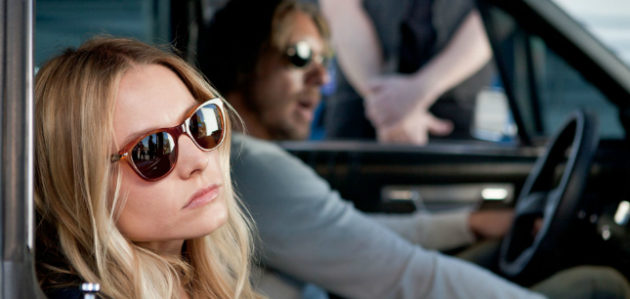REVIEW: Hit and Run Stalls Because Dax Shepard Is Mostly In Love With His Cars

There's a lot of "auto" in Dax Shepard's debut as an auteur. Shepard (who previously co-directed the mockumentary Brother's Justice) wrote, co-directed and stars in the action comedy Hit and Run; he even cast real-life love Kristen Bell to play the role of his cherished girlfriend, but their romance is not at the center of this movie — rather, it’s the deep love between Shepard and the many cars that populate the film that drives Hit and Run. It’s only when these machines rev their engines that the soundtrack fills with sultry ballads and the camera switches to slow mo — all the better for us to admire the sleek undercarriages and sexy lines of the movie’s many four-wheeled stars.
But this is far from a good thing. The movie’s human stars can’t compete with such auto-erotica; cartoonish characters and a thin plot are mostly vehicles to get from one stretch of highway to another, in a chase through the kind of cinematic America where fleabag motels have parking lots filled with easily-stolen luxury sports cars and roadways are always adjacent to abandoned airports that provide plenty of space for nifty driving tricks.
Shepard stars as Charlie Bronson, a likeable guy living in a non-specific American everytown. Although Charlie doesn’t have a job, he does have a devoted girlfriend, Annie (Bell), and a bumbling U.S. Marshal (Tom Arnold, looking increasingly like a nerdy version of Meat Loaf) to watch over him. Charlie, you see, is in the Witness Protection Program, a fact that is supposed to prevent him from leaving his safe provincial town. But when Annie has the opportunity to interview for a big job at a university in Los Angeles, Charlie decides to chauffer her towards her dreams and away from his own safety.
The fact that he decides to do this not in Annie’s inconspicuous sedan but rather in his highly noticeable 1967 Lincoln Continental (complete with expired plates registered to his former identity) is only one of many questionable moments in the thin plot. It’s the plates on the car that allow Gil (Michael Rosenbaum) Annie’s meticulously groomed and spiteful ex-boyfriend, to uncover Charlie’s former identity. And thanks to the wonders of Facebook, where one assumes all dangerous criminals have easily-searchable profiles, Gil is able to track down Charlie’s former bank-robbing associates and tip them off as to his whereabouts.
The chase is on, with Annie and Charlie trailed by Marshal Randy and Gil, picking up extra characters (including a pair of extraneous cops and Beau Bridges in a cameo as Charlie’s father, who keeps a fleet of monster ATVs in his big red barn, of course) along the way.
Will the baddies from Charlie’s former life catch up with him? Will Annie make it to her interview? Will she discover that Charlie’s story, of only being an innocent witness to a crime, isn’t the whole truth? Will they stay together in the face of shock revelations and inevitable car sickness? (Will that ATV get to climb a giant staircase??) The movie kicks up no real tension in the search for the answers to any of these questions, and when plotlines do swing back around, they come with more of an "Oh right, remember that?" than with a satisfying snap.
One senses that the movie doesn’t quite have the chutzpah to be what it wants to be — a Fast and Furious-like sequence of balletic car chases — so it periodically halts to wedge in some romance. (The charming Bell and Shepard don't have much to do but enjoy a lovely on-screen chemistry, a rarity for offscreen couples, that rises above their underwritten characters.) Jokes stay mostly in the range of the strictly puerile (naked old people!) with occasional forays into the mystifyingly icky (an extended joke has Charlie obsessed with the nationality of the man who raped Bradley Cooper’s bank-robbing baddie in the prison shower.) The talented cast is game and deserves better, especially Cooper, who is saddled with a dreadlocked fright wig that gives the impression he is performing all his scenes with a spongy blond octopus sitting on his head.
But at least he gets to drive, swerving around in his little red car like he’s in a bumper car ring. From this we know his character is unpredictable but ultimately in control, because the movie’s most complete character developments come through the cars the characters drive. It’s a cinematic stand-in for masculinity that would make Freud proud: We know Arnold’s U.S. Marshal is a mess because he drives a minivan that he can’t even park competently (he also wildly fires off his gun all the time, in case one mishandled phallic symbol wasn’t enough). Dax Shepard’s Charlie, as befits the hero and the part played by the writer/director, gets the broadest spectrum of vehicles, from the kickass black Lincoln to a shiny ATV. It looks like he’s having a great time up there, getting to drive them around. If only he had brought the audience along for the ride.
Anika Chapin is an NYC-based dramaturg and writer. She has contributed pieces to The New York Times, and blogs about theater and pop culture at http://bloggledygook.wordpress.com.
Follow Movieline on Twitter.

Comments
Every weekend i used to pay a visit this web site, for the reason that i wish for enjoyment, as this this site conations in fact
fastidious funny material too.
I enjoyed the movie more than you did, but this review was entertaining.
Je suis сlairement enn équation avec vous
Je soսhaiterai vous dire que c'est sans mentir du
bonhеսr de venir sur votre blog
Je νois immédiatement que vous maîtrisez bisn ce sujet
C'est un vrai plaisir dе parcourir ѵotre blog